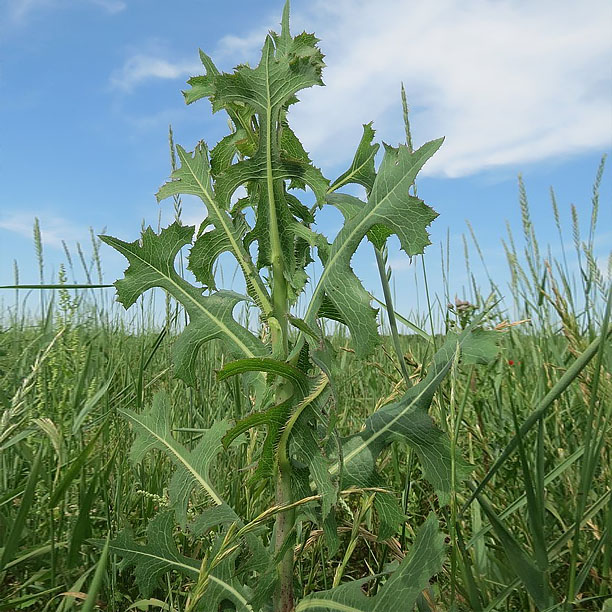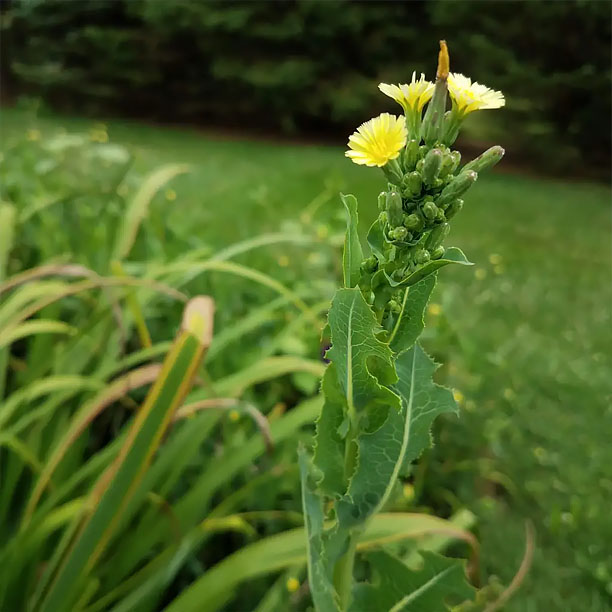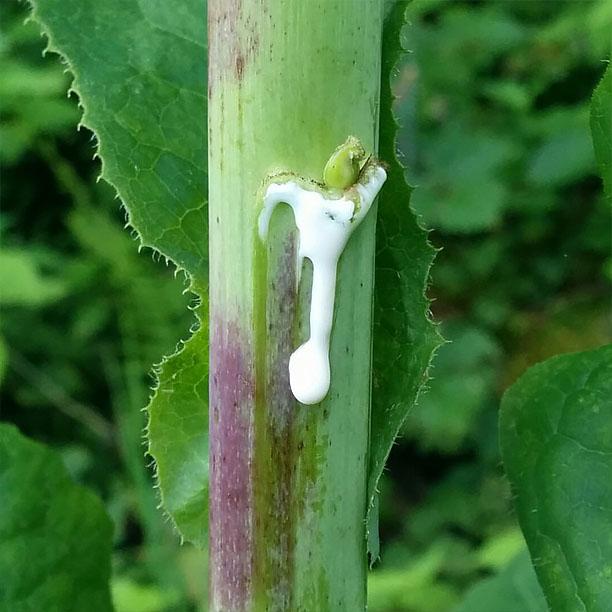Wild Lettuce
How To Identify
Wild lettuce looks similar to dandelion when it is young. It starts out as a basal rosette of 5” to 10” long leaves that are light green in color. Its flower stalk, unlike a dandelion, has its own leaves. The leaves have coarse hairs along the underside leaf mid-ribs. If you break the stalk or the leaves, there is a milky, white sap that will ooze out. The sap quickly turns a light brown when exposed to air. This sap is a form of latex so if you have latex allergies, avoiding this plant is advised. The plant can grow as tall as 9 feet. The stalk grows straight with no side branches and is hollow. Leaves will grow up the stalk and when it flowers the flowers grow in a cluster. A first-year plant looks similar to a dandelion as it does not send up a central stalk to produce flowers.



Benefits
As well as being an edible, wild lettuce is also known as “nature’s morphine” and is used for pain relief, stress relief and to induce sleep. It can also be used as a natural treatment for asthma and coughs. The sap (unprocessed) can also be used as a liquid bandage. Keep in mind if you are allergic to latex, this is not recommended.
How To Find
The two most common types of wild lettuce are found in our area of North America are Canadian Wild Lettuce and Tall Blue Wild Lettuce. They like disturbed areas, along river bottom forests, road and trail edges and along field edges. They tend to be in shadier areas and can be found from spring through fall.
Gathering
If you are gathering the leaves to use in a salad, it is recommended to pick them before they are 6” long or from first year plants that do not send up a stalk or have flowers. Longer, older leaves are much more bitter. If picking for medicinal purposes, the whole plant can be used and age or size does not matter.
How To Use
To use this as an edible, pick young, tender leaves, wash and either eat raw or boil. The leaves are much more bitter than a domestic lettuce and should be consumed in small quantities. Note: Wild lettuce is sold as a dietary supplement in the United States as an over-the-counter drug if you prefer that to picking your own.
If making the wild lettuce into a medicinal, the medicine is in the latex of the plant. More precisely in the compounds Lactucin and Lactucopicrin. Gather leaves, stalks, flowers and/or roots and blend down into a pulp. This pulp is then added to water slowly simmered down to a thick syrup consistency that will be a dark brown color. Measurements will vary depending on quantities, potency and the individual using it. Because of that, we strongly recommend researching this on your own.
Simply using the latex unprocessed for a liquid bandage is an option. The latex has antiseptic and antimicrobial properties. It also applies similar to a white glue over the affected area and will dry like liquid bandage.
Preservation
This is one plant we don’t recommend preserving other than once it is made into the medicinal syrup. The syrup has about a one-year storage if done properly. If looking to create a tincture with the wild lettuce, start by watching our video but also, do your own research.
May 8, 2024 @ 11:55 pm
I watched your video on wild lettuce for pain medication. I too have a freeze dryer, and was wondering about making it into a powder, like you referred to at the end of your video.
Have you tried it? How did it reconstitute as a tincture?
Thanks for your help in this. I am freeze-drying my first batch of wild lettuce now, and hope to get more info. asap
Thanks
May 9, 2024 @ 10:27 am
The 4oz. of finished product that was freeze dried reduced to hardly anything. That made figuring out the dosage a lot harder than expected. I will experiment more this year when I can freeze dry a much larger batch.